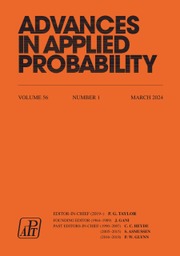Article contents
Giant components in three-parameter random directed graphs
Published online by Cambridge University Press: 01 July 2016
Abstract
A three-parameter model of a random directed graph (digraph) is specified by the probability of ‘up arrows' from vertex i to vertex j where i < j, the probability of ‘down arrows' from i to j where i ≥ j, and the probability of bidirectional arrows between i and j. In this model, a phase transition—the abrupt appearance of a giant strongly connected component—takes place as the parameters cross a critical surface. The critical surface is determined explicitly. Before the giant component appears, almost surely all non-trivial components are small cycles. The asymptotic probability that the digraph contains no cycles of length 3 or more is computed explicitly. This model and its analysis are motivated by the theory of food webs in ecology.
- Type
- Research Article
- Information
- Copyright
- Copyright © Applied Probability Trust 1992
References
- 7
- Cited by


